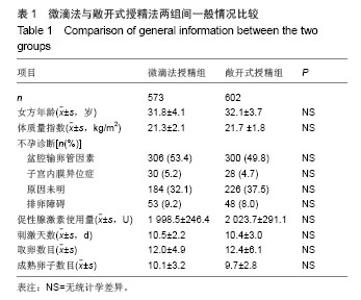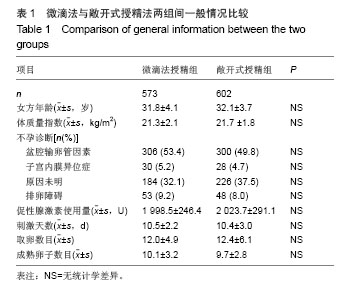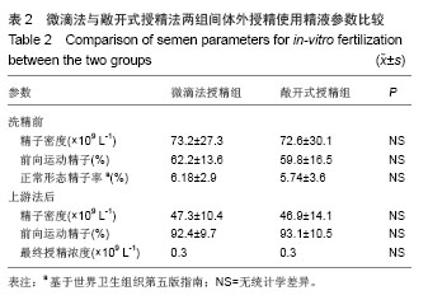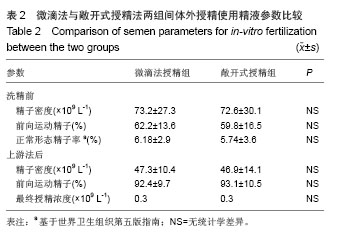Chinese Journal of Tissue Engineering Research ›› 2014, Vol. 18 ›› Issue (27): 4406-4411.doi: 10.3969/j.issn.2095-4344.2014.27.023
Previous Articles Next Articles
Comparison of two common insemination methods on in-vitro fertilization and embryo transfer
Luo Can-qiao, Li Yu-bin, Li Tao, Xiao Shan, Long Ling-li, Xie Wen-lin, Nie Zhao-ming
- The First Affiliated Hospital of Sun Yat-sen University, Guangzhou 510000, Guangdong Province, China
-
Online:2014-06-30Published:2014-06-30 -
Contact:Li Yu-bin, M.D., Attending physician, the First Affiliated Hospital of Sun Yat-sen University, Guangzhou 510000, Guangdong Province, China -
About author:Luo Can-qiao, Associate chief technician, the First Affiliated Hospital of Sun Yat-sen University, Guangzhou 510000, Guangdong Province, China -
Supported by:the National Natural Science Foundation of China, No. 81100470, 81270750; Young Teachers Cultivation Project of Sun Yat-sen University, No. 12ykpy24; the Natural Science Foundation of Guangdong Province, No. S2012010009390
CLC Number:
Cite this article
Luo Can-qiao, Li Yu-bin, Li Tao, Xiao Shan, Long Ling-li, Xie Wen-lin, Nie Zhao-ming. Comparison of two common insemination methods on in-vitro fertilization and embryo transfer[J]. Chinese Journal of Tissue Engineering Research, 2014, 18(27): 4406-4411.
share this article
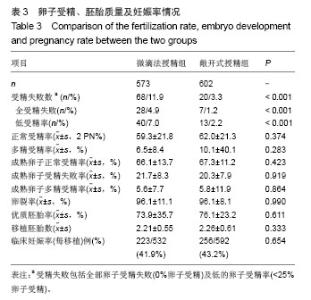
2.3 受精情况比较 本组中从1 175名妇女中总计取到14 360枚卵子。在微滴授精组,收集573名妇女的6 887枚卵子;而在敞开式授精组收集了602名妇女7 473枚卵子用于研究。在微滴式授精组28例患者出现了完全不受精(TFF),40例患者出现低的受精率(<25%卵子受精),即68/573 (11.9%);然而在敞开式授精组只有7例患者完全不受精,13例患者患者出现低的受精率,即20/602(3.3%)。因此微滴式授精组比敞开式授精组出现更高的受精失败率,分别是11.9%和3.3%(P < 0.001,表3)。但是正常受精率(2PN%)、成熟卵子正常受精率和多精受精率在两组间差异均无显著性意义(表3)。 2.4 体外授精-胚胎移植临床结果 胚胎卵裂率、优质胚胎率在两组间差别也无显著性差异(表3)。在微滴法组每移植周期的妊娠率为41.9%,与敞开式组妊娠率43.2%间差异亦无显著性意义(P=0.654,表3)。上述结果显示2种授精方法并未影响到体外授精助孕新鲜周期临床结局。"
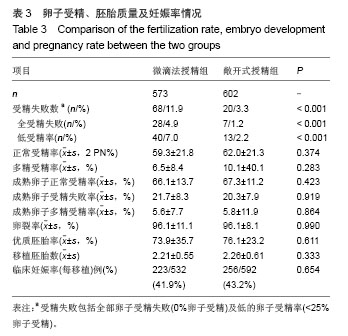
| [1]Clarke GN. A.R.T. and history, 1678-1978.Hum Reprod.2006; 21(7): 1645-1650. [2]Yovich JL. A clinician's personal view of assisted reproductive technology over 35 years. Reprod Biol. 2011;11(Suppl 3): 31-42. [3]Bianchi E, Doe B, Goulding D, et al.Juno is the egg Izumo receptor and is essential for mammalian fertilization. Nature. 2014;08(7497):483-487. [4]Parmegiani L,Cognigni GE,Filicori M.Sperm selection: effect on sperm DNA quality. Adv Exp Med Biol.2014;791:151-172. [5]Vanden Meerschaut F,Nikiforaki D,Heindryckx B,et al. Assisted oocyte activation following ICSI fertilization failure. Reprod Biomed Online. 2014;28(5):560-571. [6]Strowitzki T.In vitro maturation (IVM) of human oocytes. Arch Gynecol Obstet. 2013;288(5):971-975. [7]Manipalviratn S,Decherney A. Clinical application of human oocyte cryopreservation. Rev Recent Clin Trials.2008;3(2): 104-110. [8]Basille C, Frydman R, El Aly A, et al.Preimplantation genetic diagnosis: state of the art.Eur J Obstet Gynecol Reprod Biol. 2009;45(1):9-13. [9]Kalra SK, Molinaro TA. The association of in vitro fertilization and perinatal morbidity.Semin Reprod Med.2008;26(5): 423-435. [10]Palermo GD,Neri QV,Rosenwaks Z. Safety of intracytoplasmic sperm injection.Methods Mol Biol. 2014; 1154:549-562. [11]Farhangniya M, Dortaj Rabori E, Mozafari Kermani R, et al. Comparison of Congenital Abnormalities of Infants Conceived by Assisted Reproductive Techniques versus Infants with Natural Conception in Tehran.Int J Fertil Steril. 2013;7(3): 217-224. [12]Dai SJ, Qiao YH, Jin HX, et al. Effect of coincubation time of sperm-oocytes on fertilization, embryonic development, and subsequent pregnancy outcome. Syst Biol Reprod Med.2012;58(6):348-353. [13]Marianowski P, Szymusik I, Grzechocinska B, et al. The comparison of two different embryo culture methods in the course of in vitro fertilization program. Folia Histochem Cytobiol.2007;45(Suppl 1):S115-117. [14]Suh RS, Zhu X, Phadke N, et al.IVF within microfluidic channels requires lower total numbers and lower concentrations of sperm. Hum Reprod.2006; 21(2):477-483. [15]Gianaroli L,Cristina Magli M,et al.Reducing the time of sperm-oocyte interaction in human in-vitro fertilization improves the implantation rate. Hum Reprod.1996;11(1):166-171. [16]Boone WR, Johnson JE. The effect of the culture vessel and insemination method on the in vitro fertilization and development of human oocytes. J Assist Reprod Genet. 1997; 14(4): 233-235. [17]Murray KS, James A, McGeady JB, et al.The effect of the new 2010 World Health Organization criteria for semen analyses on male infertility.Fertil Steril.2012;98(6):1428-1431. [18]Johnson LN,Sasson IE,Sammel MD,et al. Does intracytoplasmic sperm injection improve the fertilization rate and decrease the totalfertilization failure rate in couples with well-defined unexplained infertility? A systematic review and meta-analysis.Fertil Steril. 2013;100(3):704-711. [19]Cummins JM, Breen TM, Harrison KL, et al. A formula for scoring human embryo growth rates in in vitro fertilization: its value in predicting pregnancy and in comparison with visual estimates of embryo quality. J In Vitro Fert Embryo Transf. 1986;3(5): 284-295. [20]Allgeyer M, Kirschenhofer N, Mann U, et al. Measurement of induced acrosome reactions in human sperm using physiologic stimuli--relevance for the prediction of fertilization outcome. Andrologia.2006;38(3): 99-105. [21]Pacey AA. Assessment of male factor.Best Pract Res Clin Obstet Gynaecol. 2012;26(6):739-746. [22]Chiamchanya C,Tor-udom P,Gamnarai N. Comparative study of intracytoplasmic sperm injection and in vitro fertilization with high insemination concentration in sibling oocytes in the treatment of unexplained infertility.J Med Assoc Thai. 2008; 91(8):1155-1160. [23]Zhu Y,Wu QF,Zhou XJ,et al.ICSI improves fertilization in isolated teratozoospermic men: a study with strictly controlled external factors and WHO-5 standard. Syst Biol Reprod Med. 2013;59(1):21-26. [24]Liu DY, Baker H W. Defective sperm-zona pellucida interaction: a major cause of failure of fertilization in clinical in-vitro fertilization. Hum Reprod. 2000;15(3):702-708. [25]Morbeck DE,Khan Z,Barnidge DR,el al.Washing mineral oil reduces contaminants and embryotoxicity. Fertil Steril.2010; 94(7):2747-2752. [26]Hughes PM, Morbeck DE, Hudson SB, et al. Peroxides in mineral oil used for in vitro fertilization: defining limits of standard quality control assays. J Assist Reprod Genet.2010; 27(2-3):87-92. [27]Sifer C, Pont JC, Porcher R, et al. A prospective randomized study to compare four different mineral oils used to culture human embryos in IVF/ICSI treatments. Eur J Obstet Gynecol Reprod Biol.2009;147(1):52-56. [28]Otsuki J, Nagai Y, Chiba K. Peroxidation of mineral oil used in droplet culture is detrimental to fertilization and embryo development. Fertil Steril. 2007;88(3): 741-743. [29]Li LF,Xiang C, Zhu YB,et al.Modeling of progesterone-induced intracellular calcium signaling in human spermatozoa.J Theor Biol.2014;351:58-66. [30]Sagare-Patil V, Vernekar M, Galvankar M, et al. Progesterone utilizes the PI3K-AKT pathway in human spermatozoa to regulate motility and hyperactivation but not acrosome reaction. Mol Cell Endocrinol.2013;374(1-2):82-91. [31]Hsu MC, Wang JY, Lee YJ, et al.Kisspeptin modulates fertilization capacity of mouse spermatozoa. Reproduction. 2014;147(6):835-845. [32]Swain JE.Optimizing the culture environment in the IVF laboratory: impact of pH and buffer capacity on gamete and embryo quality. Reprod Biomed Online. 2010;21(1):6-16. [33]Swain JE. Is there an optimal pH for culture media used in clinical IVF? Hum Reprod Update.2012;18(3):333-339. [34]Männikkö M,Törmälä RM,Tuuri T,et al.Association between sequence variations in genes encoding human zona pellucida glycoproteins and fertilization failure in IVF. Hum Reprod.2005; 20(6):1578-1585. [35]Roth LW, McCallie B, Alvero R, et al. Altered microRNA and gene expression in the follicular fluid of women with polycystic ovary syndrome.J Assist Reprod Genet.2014;31(3):355-362. [36]Hovatta O.Ovarian function and in vitro fertilization (IVF) in Turner syndrome.Pediatr Endocrinol Rev.2012;9 Suppl 2: 713-717. [37]Kilic S, Tasdemir N, Yilmaz N, et al. The effect of anti-thyroid antibodies on endometrial volume, embryo grade and IVF outcome.Gynecol Endocrinol.2008;24(11):649-655. [38]Xie Y, Wang F, Puscheck EE, et al.Pipetting causes shear stress and elevation of phosphorylated stress-activated protein kinase/jun kinase in preimplantation embryos. Mol Reprod Dev.2007;74(10):1287-1294. [39]Kawamura K,Chen Y,Shu Y,et al.Promotion of human early embryonic development and blastocyst outgrowth in vitro using autocrine/paracrine growth factors. PLoS One. 2012; 7(11):e49328. [40]Morbeck DE, Leonard PH. Culture systems: mineral oil overlay.Methods Mol Biol.2012;912:325-331. [41]Pregl Breznik B, Kova?i? B, Vlaisavljevi? V. Are sperm DNA fragmentation, hyperactivation, and hyaluronan-binding ability predictive for fertilization and embryo development in in vitro fertilization and intracytoplasmic sperm injection? Fertil Steril. 2013;99(5):1233-1241. [42]Swain JE, Pool TB. ART failure: oocyte contributions to unsuccessful fertilization. Hum Reprod Update.2008; 14(5): 431-446. [43]Shuai HL, Ye Q, Huang YH, et al.Comparison of conventional in vitro fertilisation and intracytoplasmic sperm injection outcomes in patients with moderate oligoasthenozoospermia. Andrologia. 2014 May 9. [44]Miyahara Y, Makihara N, Yamasaki Y, et al.In vitro fertilization-embryo transfer pregnancy was a risk factor for hemorrhagic shock in women with placental polyp.Gynecol Endocrinol. 2014. [Epub ahead of print]. [45]Lu Q, Shen H, Li Y, et al.Low testosterone levels in women with diminished ovarian reserve impair embryo implantation rate: a retrospective case-control study.J Assist Reprod Genet. 2014;31(4):485-491. [46]Ye H, Huang GN, Cao YX, et al. [Effect of domestic highly purified urinary follicle stimulating hormone on outcomes of in vitro fertilization-embryo transfer in controlled ovarian stimulation].Zhonghua Fu Chan Ke Za Zhi. 2013;48(11): 838-842. [47]Jayaprakasan K, Pandian D, Hopkisson J, et al. Effect of ethnicity on live birth rates after in vitro fertilisation or intracytoplasmic sperm injection treatment.BJOG. 2014; 121(3): 300-306. [48]Cedars MI. National reporting of in vitro fertilization success rates: how do we get patients useful information?Fertil Steril. 2013;100(5):1210-1011. [49]Guivarc'h-Levêque A, Jaffré F, Homer L, et al. [GnRH agonist triggering in IVF and luteal phase support in women at risk of ovarian hyperstimulation syndrome].Gynecol Obstet Fertil. 2013;41(9):511-514. [50]Kirkegaard K, Hindkjaer JJ, Ingerslev HJ.Hatching of in vitro fertilized human embryos is influenced by fertilization method. Fertil Steril. 2013;100(5):1277-1282. [51]Vialard F, El Sirkasi M, Tronchon V, et al.Tumor necrosis factor-308 polymorphism increases the embryo implantation rate in women undergoing in vitro fertilization.Hum Reprod. 2013; 28(10):2774-2783. [52]Ji J, Liu Y, Tong XH, et al.The optimum number of oocytes in IVF treatment: an analysis of 2455 cycles in China.Hum Reprod. 2013;28(10):2728-2734. [53]Ortega-Hrepich C, Stoop D, Guzmán L, et al.A "freeze-all" embryo strategy after in vitro maturation: a novel approach in women with polycystic ovary syndrome?Fertil Steril. 2013; 100(4):1002-1007. [54]Manheimer E, van der Windt D, Cheng K, et al.The effects of acupuncture on rates of clinical pregnancy among women undergoing in vitro fertilization: a systematic review and meta-analysis.Hum Reprod Update. 2013;19(6):696-713. |
| [1] | Li Hong, Wu Shaohua, Qiu Mingxing, Deng Qingfu, Lei Guolin, Li Qinglong. Mechanism underlying basic fibroblast growth factor and insulin-like growth factor-1 effects on proliferation and apoptosis of spermatogonial stem cells [J]. Chinese Journal of Tissue Engineering Research, 2020, 24(19): 3017-3022. |
| [2] | Song Hui, He Tao, Li Gen, Dong Yu-qi, Zhang Chao. In vitro evaluation of silver ion implantation into titanium dioxide coating against Staphylococcus aureus [J]. Chinese Journal of Tissue Engineering Research, 2018, 22(18): 2910-2914. |
| [3] | Huang Yuan-li, Ke Lin-nan, Li Chang-kun, Wang Chun-ren . Simultaneous determination of 18 different amino acids in in vitro fertilization medium by ultra-high performance liquid chromatography–tandem mass-spectrometry [J]. Chinese Journal of Tissue Engineering Research, 2018, 22(18): 2915-2920. |
| [4] | Li Pei, Zhang Jing, Jin Xuan. Effect of body mass index on outcomes of in vitro fertilization for infertile females at different ages [J]. Chinese Journal of Tissue Engineering Research, 2016, 20(15): 2212-2217. |
| [5] | Li Jun-tao, Zhang Pei-hai, Qu Xiao-wei, Li Zheng-sheng, Li Song-wei. Seminiferous capsule extract effect on the proliferation of spermatogonial stem cells [J]. Chinese Journal of Tissue Engineering Research, 2016, 20(14): 2104-2109. |
| [6] | Chen Dong-si, Qi Xiu-juan, Liu Jian-xin, Ding Yu, Ma Wen-cong . Modified isolation and culture methods of human ovarian granulosa cells [J]. Chinese Journal of Tissue Engineering Research, 2015, 19(46): 7456-7460. |
| [7] | Luo Yue-ji, Zeng Jie, Tang Rui-ling, Wang Xing-ming, Fan Li-qing. Spermatogonial stem cells and their biological characteristics: current situation, advances and applications [J]. Chinese Journal of Tissue Engineering Research, 2015, 19(14): 2291-2296. |
| [8] | Wang Fang, Chen Shao-wei. Reproductive effects of in vitro fertilization-embryo transfer: in vitro culture and cryopreservation of embryos [J]. Chinese Journal of Tissue Engineering Research, 2014, 18(18): 2939-2944. |
| [9] | Liu Shan-shan, Xu Li-ping, Zhu Wei-yun, Ma Ning-fang. Application of Accutase enzymes in the separation of spermatogonial stem cells [J]. Chinese Journal of Tissue Engineering Research, 2013, 17(45): 7904-7910. |
| Viewed | ||||||
|
Full text |
|
|||||
|
Abstract |
|
|||||
